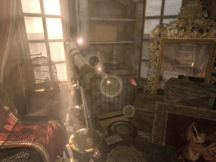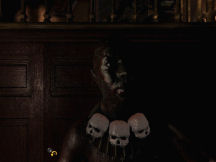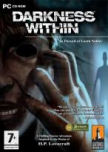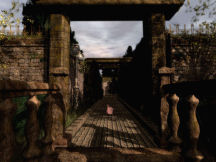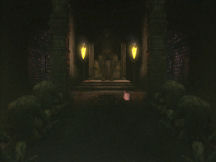Have you ever tried to stay awake because
sleep brought recurrent nightmares? Have you hesitated to open a door
because what's behind it might be too horrible to bear? Or have you
worried that reality is slipping away as you see the impossible happening
around you? Welcome to the world of Darkness Within: In Pursuit of
Loath Nolder, the first release in a planned adventure trilogy.
Step Into My Parlor...
Darkness Within is set in a generously large gameworld centered
around the imaginary town of Wellsmoth. H.P. Lovecraft is a particular
inspiration for the game, but Edgar Allan Poe would also have felt right
at home here. You assume the role of police detective Howard E. Loreid.
The year is 2011. Loreid is investigating the sudden disappearance of
private eye Loath Nolder, the prime suspect in a recent murder.
As Detective Loreid, you sleuth your way through Victorian gothic
mansions, murky underground caves and a cemetery that seems like an
antique work of art. You also slip into dream worlds, visions and
nightmares. This happens so easily that you often question what is real
and what is an illusion.
...Said the Spider to the Fly
For a truly creepy gaming experience, attention must be paid to the
audio elements, and here the developers of Darkness Within do not
disappoint. Ambient sounds are realistic and effective, including ticking
clocks, cawing birds, creaking doors, mysterious knocks, distant howls and
the sound of muffled human voices. The music often merges with the
ambient sound layer and is unusually varied. You'll hear primitive drums,
eerie pipes and keyboard tones, insistent strings, and haunting echoes.
There isn't a lot of speech in this game, but what's there is
professionally voiced. You can click through conversations, and also
replay them. Replaying can be important because clues and plot
information are woven into the conversations. Howard Loreid's thoughts
appear as text and aren't voiced -- this works well and effectively
heightens the occasions when you do hear voices. A fast reader can also
elect to click quickly through Loreid's thoughts.
And as for reading -- there's a lot of it in this game: private
journals, newspaper articles, letters, and poems. These advance the plot
and provide clues to the murder and disappearance. The quality of the
writing varies. The murder victim's journal has an old-world flavor, with
elaborate descriptions and outpourings of doubt and fear. The poetry is a
bit clumsy though, especially when sticking doggedly to the rhyme scheme.
Character models are not one of the game's strengths, but since the
actors in this dark drama appear but briefly (and often in shadow), this
shortcoming is minimized.
Make Yourself Comfortable
The gamer chooses a difficulty level when beginning the game. I
recommend the "Standard" setting -- the easiest. Two other levels are for
those relentless, genius types who enjoy gleaning every detail and
independently solving puzzles, no matter how arduous. Thankfully, the
"Standard" level provides in-game help for the rest of us mere mortals.
You can further customize your experience by individually
enabling/disabling the Automatic Document Research option, the Clue Counts
(this will post the number of clues in each document) and Hints.
An option screen allows multiple tweaks for video, audio, and gameplay
settings. The game has a generous fifty saved game slots -- though I
could have used even more.
Darkness Within uses a point-and-click interface with first
person perspective and 360 degree panning. You can opt to have the cursor
sweep the edges of the screen in panoramic style, or you can use a fixed
cursor for 360 turning (my preference). Movement from node to node is
easy and smooth.
Right-clicking brings up the inventory screen, including a magnifying
glass icon, which allows you to examine inventory. A brain icon
represents Howard's Mind (described in more detail below). I strongly
recommend reading the manual before you start the game to learn about this
and other innovative features.
At the end of the game a Game Results screen indicates total time
expended (I played for nearly twenty hours); how many Documents, Clues,
Hidden Clues, Story Secrets and Easter Eggs were found; and the final
score. I received the lowest score -- one star out of a possible twenty.
This didn't bother me (much) and won't affect how strictly I grade this
game. Much.
Admire the Scenic View
Interior environments in Darkness Within reveal a world of
intriguing detail, including period furniture, paintings on the walls, and
carved moldings. The game uses light and shadow to unusual effect. For
instance, lamps in the Field mansion have latticed shades that cast eerie
web-like designs on the walls. Moonlight pours through the windows,
illuminating dust motes floating in the air.
At the beginning, exploration is confined to disturbing, enclosed
places. Just when you think you'll never see the out-of-doors, you break
out into spaces with open sky. Though the gamer won't encounter a huge
overarching landscape, certain exteriors bring intense release from the
sensation of gathering menace. Brief cut scenes effectively expand the
plot and add to the atmosphere.
Entertainment is Provided
Darkness Within contains a variety of puzzles: some inventory
based, some involving patterns and symbols, and a few mechanical "twiddle"
challenges. All are entertaining to puzzle out and most are fairly
clued. Pixel hunts are rare; it's easy to find the bulk of the items and
locations. The game allows you to look at inventory items in close-up
view and rotate them. In fact, doing so is essential.
Some of the written materials must be reviewed closely. When a
document can be "researched," a menu appears on the bottom left of the
screen. It contains a pen for underlining information. As noted in the
manual, in "Standard" mode a magnifying glass will identify the important
parts of the text for you. This is extremely helpful when you tire of
searching the documents.
Unfortunately, some important information in the documents only reacts
to underlining after a "trigger" occurs late in the game. So it is
possible to underline every phrase in a document without receiving all the
potential responses, and then have to do it all over again when the plot
has advanced. (This tedious re-underlining activity was not my favorite
aspect of the game.)
A novel game feature allows access to Howard's Mind, where the gamer
explores Howard's ideas and impressions and views of his surroundings.
Howard's "thoughts" become accessible as certain events occur. Other
thoughts are placed in Howard's Mind after you underline important
information in documents. You then combine thoughts and/or inventory
items to learn more about the story, speculate about the characters, or
decide what to do next in the game. A couple of the thought combinations
seemed a bit arbitrary. However, on the whole I enjoyed Howard's Mind
immensely. I only wish that more of the seemingly-related thoughts and
observations had given a result when combined, even if these weren't
actually necessary to advance the plot or help solve a puzzle.
One puzzle was particularly poorly clued -- the hand-held device
requiring two dates. For one date the clues were so tenuous that I had to
consult a walkthrough. For the second date, I probably inputted a hundred
dates before solving it (using both American and European month and date
sequences, as both are found in the game). I finally found a date that
worked, but a journal discrepancy still leaves me confused.
And At Midnight -- A Long-Anticipated Snack
The complexity of the plot provides its own puzzle. I needed to read
all the journal entries, letters, and other documents two or three times
(and to construct a timeline) before I began to understand the darkness
that was within, without and beneath the strange little town of Wellsmoth.
Plot reconstruction (and understanding the themes it hinted at) was my
favorite challenge in the game.
However, even after piecing together the elements of the plot, I
thought that the story was unfinished. There are letters to and from
people who are otherwise unidentified, names and events in newspaper
articles without any follow-up, names on stone sarcophagi that seem
meaningless. Did I miss a big chunk of the story? (Entirely possible,
since the Game Results screen tells me that I've discovered only two out
of five "story secrets.") Or did I stumble across references to
characters and events that will only appear in the second and third games
in the Darkness Within trilogy?
This makes me more than eager to play the next two Darkness Within
games when they release. Make it soon.
Quick List for Darkness Within: In Pursuit of Loath Nolder
A surprisingly attractive, intricate puzzle horror adventure from a new
team of developers. This is the first game in a planned trilogy. First
person, point-and-click, 360 degree panning.
Varied and immersive environments, truckloads of atmosphere. Very
little character interaction, lots of reading. Excellent voiceovers,
ambient sounds, and background music. The plot is intriguing and
well-handled, but the game's resolution leaves the meaning behind certain
events, symbols and people as a continuing mystery.
Three difficulty levels -- I recommend "Standard" (the easiest).
Admirable puzzle innovations and tension-enhancing gameplay. Inventory and
research challenges, pattern interpretation. Read the manual to find out
more about the game's novel tools. Two particularly difficult challenges
-- a puzzle in which you adjust concentric rings, and times when you must
underline specific information and combine these "thoughts" correctly. No
sliders, no mazes, no sound or color discrimination puzzles, one easy
timed puzzle.
50 saved game slots. You can fail a couple of times, but will be taken
immediately to the moment before your wrong move/decision. You can't die.
No problems with installation, no crashes, one minor glitch that was
reversed by hitting the "Esc" key. If you sit patiently through the
credits, you'll be rewarded.
Darkness Within: In Pursuit of Loath Nolder is aimed at gamers
who enjoy psychological horror that doesn't descend into on-screen
violence. Also aimed at gamers who enjoy immersive, detailed environments
surrounding a gradually unfolding mystery.
Final Grade: B+
My Computer Specs:
Windows XP Professional
Pentium 2.80 GHz
2046 MB RAM
Direct X 9.0c
512 MB NVIDIA GeForce 7800 GTX
SB X-Fi Audio
December 2007
design copyright ©
2007
GameBoomers
Group
